European Union Smart Mobility–Aspects Connected with Bike Road System’s Extension and Dissemination
Abstract
1. Introduction
- C1: To investigate what are the differences in bicycle road systems between smart cities in European Union Countries.
- C2: To investigate the amount of bicycle roads per 1 km2 and 1000 citizens in European Union countries’ smart cities.
- C3: To investigate whether the dissemination of smart city bicycle road systems in European Union countries is correlated with the average temperature of the country.
- C4. To investigate whether the dissemination of smart city bicycle road systems in European Union countries is correlated with the GPD per capita of the country.
- To realize those goals, the following scientific hypothesis were formulated:
- H1. The average length of a bicycle path in smart cities is correlated with the average temperature of the country.
- H2. The average length of a bicycle path in smart cities per 100 inhabitants is correlated with the average temperature of the country.
- H3. The average length of a bicycle path in smart cities per 1 km2 is correlated with the average temperature of the country.
- H4. The average length of a bicycle path in smart cities is correlated with the GPD per capita of the country.
2. Literature Review
- The sustainable and efficient use of resources such as energy, water, and transportation;
- High-quality and accessible public services and infrastructure;
- A robust and integrated Information and Communication Technology (ICT) infrastructure;
- Active citizen engagement and participation;
- Innovative solutions for urban challenges and continuous improvement;
- A safe and secure living environment;
- Data-driven decision-making and management;
- The integration of various urban systems such as transportation, healthcare, education, and energy.
- Improved health and wellness: Biking is a great form of physical activity that can improve health and wellness.
- Reduced traffic congestion: Biking can reduce traffic congestion, leading to smoother and faster commutes.
- Lower carbon footprint: Biking produces no emissions, making it an environmentally friendly mode of transportation.
- Cost savings: Biking eliminates the need for fuel and maintenance costs, making it a cost-effective mode of transportation.
- Increased mobility: Biking provides a flexible and convenient mode of transportation, especially in densely populated areas.
- Improved air quality: Biking reduces air pollution, leading to cleaner air and better public health.Enhanced public safety: Biking creates a safer environment by reducing the number of cars on the road and reducing the risk of accidents.
- Increased social interaction: Biking promotes social interaction and community engagement, as it encourages people to get out and interact with others.
- Improved access to services and amenities: Biking provides improved access to services and amenities, making it easier for people to get around and access what they need.
- Promotes sustainability: Biking promotes sustainability by reducing carbon emissions, conserving energy, and reducing the demand for non-renewable resources.
- A lack of infrastructure: in some cities, there may be a lack of proper bike lanes, bike parking, and other infrastructure that is necessary for safe and convenient bike usage.
- Weather conditions: depending on the location, weather conditions such as rain, snow, and extreme heat can make bike usage difficult and unpleasant for riders.
- Theft and security concerns: bikes are often easier to steal than cars, which can be a concern for riders who leave their bikes parked in public places.
- Physical exertion: cycling can be physically demanding and may not be suitable for everyone, especially those with health problems or disabilities.
- Cost: although bikes are generally less expensive than cars, they still require an initial investment, maintenance, and replacement costs.
- Limited carrying capacity: bikes are often limited in terms of the amount of cargo they can carry, which can be a problem for people who need to transport large items or heavy equipment.
- Safety concerns: riding a bike on busy roads and intersections can be dangerous, and the risk of accidents is higher for cyclists than for drivers.
- Inconvenience: cycling may be time-consuming and less convenient than driving, especially for longer trips and errands.
3. Methodology
- There is a lack of studies about baking infrastructure on the European Union level which can be used to compare cities and countries according to it.
- There is a lack of analysis of statistical relations between the temperature and bike road systems in European Union countries.
- There is a lack of statistical analysis about PKB per capita and the country’s development of bike road infrastructure.
- There is a lack of analysis about the geographical dissemination of bike road infrastructure in the European Union and differences between particular countries.
- To interpret the correlations between indicators, the Guilford reliability classification was used. According to this approach, we can differentiate the following types of correlations [94]: 0.9 < r ≤ 1—very high,
- 0.7 < r ≤ 0.9—high;
- 0.4 < r ≤ 0.7—moderate;
- 0.2 < r ≤ 0.4—low;
- 0.00 < r ≤ 0.2—very low.
4. Results
5. Discussion
- Between the length of bicycle paths and the average temperature of the country, the linear correlation coefficient is −0.74 (a very high coefficient value according to Guilford’s classification).
- Between the ratio of the length of bicycle paths per square kilometer of surface area and the average temperature of the country, the linear correlation coefficient is −0.51 (a high coefficient value according to Guilford’s classification).
- Between the rate of bicycle path length per 1000 residents and the country’s average temperature, the linear correlation coefficient is −0.66 (a high coefficient value according to Guilford’s classification).
- Finland—the country with the highest average length of bicycle paths in smart cities.
- Estonia, Italy, Slovenia, Lithuania, Luxembourg, Belgium, and Romania—a group of countries that are below the confidence interval. This means that the length of bicycle paths in these countries in smart cities is shorter than their average temperature would suggest. These countries are investing less in bicycle infrastructure than neighboring countries with similar climate conditions.
- Germany, Denmark, the Netherlands, Austria, and Portugal—a group of countries above the confidence interval. These countries are characterized by a greater length of bicycle routes in smart cities compared to neighboring countries characterized by similar climatic conditions.
- Outlier point Finland—the country characterized by the lowest average temperature of people of the surveyed countries and the highest bike road length in smart cities per 1 square kilometer.
- Portugal, Austria, and the Netherlands—the countries characterized by a higher saturation of bicycle paths in smart cities per 1 square kilometer of area compared to neighboring countries with similar climatic conditions.
- Estonia, Italy, Slovakia, Slovenia, and Lithuania—a group of countries characterized by a lower density of bicycle paths in smart cities compared to neighboring countries with similar climatic conditions.
- Finland—again, an outlier with the highest bike road length per 1000 inhabitants in smart cities and the lowest temperature among the EU countries surveyed.
- Portugal, Spain, and the Netherlands—the countries characterized by a higher density of bikeways in smart cities as measured by the ratio of bikeway length per 1000 inhabitants compared to countries with similar climates.
- Estonia, Italy, Austria, Denmark, Luxembourg, and Slovenia—the countries characterized by a lower density of bicycle routes in smart cities compared to neighboring countries with similar climate conditions.
- The statistical analysis shows that in this case, they are statistically significant (at the level of statistical significance of α = 0.05) between the variables. Between the length of bicycle roads and the wealth of the country, measured by the coefficient of GDP per capita at purchasing power parity, the linear correlation coefficient is −0.73 (a very high coefficient value according to Guilford’s classification).
- Between the ratio of the length of bicycle paths per square kilometer of land area and the wealth of the country as measured by the ratio of GDP per capita by purchasing power parity, the linear correlation coefficient is −0.49 (an average coefficient value according to Guilford’s classification).
- Between the indicator of the length of bicycle paths per 1000 residents and the country’s wealth as measured by the GDP per capita ratio according to purchasing power parity, the linear correlation coefficient is −0.52 (a high coefficient value according to Guilford’s classification).
- Sweden, Austria, Poland, Hungry—countries whose smart cities are characterized by a greater length of bicycle roads than their wealth would suggest.
6. Conclusions
6.1. Main Results of the Paper
6.2. Limitations of the Study
6.3. Future Research
Funding
Informed Consent Statement
Data Availability Statement
Conflicts of Interest
References
- DeMaio, P. Smart Bikes: Public Transportation for the 21st Century. Available online: https://www.metrobike.net/wp-content/uploads/2013/10/Smart-Bikes.pdf (accessed on 7 January 2023).
- Wolniak, R.; Jonek-Kowalska, I. The creative services sector in Polish cities. J. Open Innov. Technol. Mark. Complex. 2022, 8, 17. [Google Scholar] [CrossRef]
- Wolniak, R.; Jonek-Kowalska, I. The quality of service to residents by public administration on the example of municipal offices in Poland. Adm. Manag. Public 2021, 37, 132–150. [Google Scholar] [CrossRef]
- Zayed, M. Towards an index of city readiness for cycling. Int. J. Transp. Sci. Technol. 2017, 5, 210–225. [Google Scholar] [CrossRef]
- Savastano, M.; Suciu, M.-C.; Gorelova, I.; Stativă, G.-A. How smart is mobility in smart cities? An analysis of citizens’ value perceptions through ICT applications. Cities 2023, 132, 104071. [Google Scholar] [CrossRef]
- Herdiansyah, H. Smart city based on community empowerment, social capital, and public trust in urban areas. Glob. J. Environ. Sci. Manag. 2023, 9, 113–128. [Google Scholar]
- Garret, A. Cost-Benefit of Cycling Infrastructure. Available online: https://cyclingsolutions.info/cost-benefit-of-cycling-infrastructure/ (accessed on 2 February 2023).
- Bicycle Facility Maintenance. Available online: https://safety.fhwa.dot.gov/PED_BIKE/univcourse/pdf/swless21.pdf (accessed on 2 February 2023).
- Maintenance Cost Estimate Report. Available online: https://www.rdbn.bc.ca/application/files/1415/8405/1429/Maintenance_Cost_Estimate_Report.pdf (accessed on 2 February 2023).
- Benevolo, C.; Dameri, R.P.; D’Auria, B. Smart mobility in smart city. In Empowering Organizations; Springer International Publishing: Cham, Switzerland, 2016; pp. 3–28. [Google Scholar]
- Kunytska, O.; Persia, L.; Gruenwald, N.; Datsenko, D.; Zakrzewska, M. The Sustainable and Smart Mobility Strategy: Country Comparative Overview; Lecture Notes in Networks and Systems; Springer: Cham, Switzerland, 2023; Volume 536, pp. 656–668. [Google Scholar]
- Dhingra, M.; Chattopadhyay, S. Advancing smartness of traditional settle-ment-case analysis of Indian and Arab old cities. Int. J. Sustain. Built Environ. 2016, 5, 549–563. [Google Scholar] [CrossRef]
- Lara, A.; Costa, E.; Furtlani, T.; Yugutcanlar, T. Smartness that matters: Comprehensive and human-cered characterization of smart cities. J. Open Innov. 2016, 2, 1–13. [Google Scholar]
- Albino, V.; Berardi, U.; Dangelico, R.M. Smart cities: Definitions, dimensions, performance, and initiatives. J. Urban Technol. 2015, 22, 3–21. [Google Scholar] [CrossRef]
- Ku, D.; Choi, M.; Lee, D.; Lee, S. The effect of a smart mobility hub based on concepts of metabolism and retrofitting. J. Clean. Prod. 2022, 379, 134709. [Google Scholar] [CrossRef]
- Huang, B.; Thomas, T.; Groenewolt, B.; van Berkum, E.C. An investigation of the motivators and barriers of smartphone app incentives for encouraging cycling. Decis. Anal. J. 2022, 5, 100127. [Google Scholar] [CrossRef]
- Agriesti, S.A.M.; Soe, R.-M.; Saif, M.A. Framework for connecting the mobility challenges in low density areas to smart mobility solutions: The case study of Estonian municipalities. Eur. Transp. Res. Rev. 2022, 14, 32. [Google Scholar] [CrossRef]
- Jan Wisniewski-RESETl. Paris’s Public Bike Sharing Schemes: Win or Fail for the Environment? 2019. Available online: https://en.reset.org/blog/pariss-public-bike-sharing-schemes-win-or-fail-environment-09302019 (accessed on 7 January 2023).
- Winslow, J.; Mont, O. Bicycle Sharing: Sustainable Value Creation and Institutionalisation Strategies in Barcelona. Sustainability 2019, 11, 728. [Google Scholar] [CrossRef]
- Guo, Y.; Yang, L.; Lu, Y.; Zhao, R. Dockless bike-sharing as a feeder mode of metro commute? The role of the feeder-related built environment: Analytical framework and empirical evidence. Sustain. Cities Soc. 2021, 65, 102594. [Google Scholar] [CrossRef]
- Komninos, N. Intelligent Cities: Innovation, Knowledge Systems and Digital Spaces; Spon Press: London, UK, 2002. [Google Scholar]
- Fontes, T.; Arantes, M.; Figuereido, P.; Novais, P. A Cluster-Based Approach Using Smartphone Data for Bike-Sharing Docking Stations Identification: Lisbon Case Study. Smart Cities 2022, 5, 251–275. [Google Scholar] [CrossRef]
- Resis, J.; Marques, P.A.; Marques, P.C. Where Are Smart Cities Heading? A Meta-Review and Guidelines for Future Research. Appl. Sci. 2022, 12, 8328. [Google Scholar] [CrossRef]
- Esashika, D.; Masiero, G.; Mauger, Y. An investigation into the elusive concept of smart cities: A systematic review and meta-synthesis. Technol. Anal. Strateg. Manag. 2021, 33, 957–969. [Google Scholar] [CrossRef]
- Brzeziński, Ł.; Wyrwicka, M.K. Fundamental Directions of the Development of the Smart Cities Concept and Solutions in Poland. Energies 2022, 15, 8213. [Google Scholar] [CrossRef]
- Prajeesh, C.B.; Pillai, A.S. Indian Smart Mobility Ecosystem—Key Visions and Missions. AIP Conf. Proc. 2022, 2555, 50005. [Google Scholar]
- Boichuk, N. Smart mobility jako podstawowy element koncepcji inteligentnego miasta—Studium przypadku wybranych polskich miast. In Inteligentne Miasta; Budziewicz-Guźlecka, A., Ed.; Rozprawy i Studia—Uniwersytet Szczeciński: Szczecin, Poland, 2020; Volume 1153, pp. 59–72. ISBN 978-83-7972-402-4. [Google Scholar]
- Deakin, M.; Al Waer, H. From intelligent to smart cities. Intell. Build. Int. 2011, 3, 133–139. [Google Scholar] [CrossRef]
- Tahmasseby, S. The Implementation of Smart Mobility for Smart Cities: A Case Study in Qatar. Civ. Eng. J. 2022, 8, 2154–2171. [Google Scholar] [CrossRef]
- Rahman, S.A.A.; Dura, N.H. Malaysia smart tourism framework: Is smart mobility relevant? Kasetsart J. Soc. Sci. 2022, 43, 1009–1014. [Google Scholar]
- Rajabi, M.S.; Habipour, M.; Bakhtiari, S.; Rad, F.M.; Aghakhani, S. The development of BPR models in smart cities using loop detectors and license plate recognition technologies: A case study. J. Future Sustain. 2023, 3, 75–84. [Google Scholar] [CrossRef]
- Christensen, H.R. Smart Biking as Gendered Innovations and Smart City Experiment? The Case of Mobike in China, Gendering Smart Mobilities; Routledge: Oxfordshire, UK, 2020; pp. 210–228. [Google Scholar]
- Simonofski, A.; Handekyn, P.; Vandennieuwenborg, C.; Wautelet, Y.; Snoeck, M. Smart mobility projects: Towards the formalization of a policy-making lifecycle. Land Use Policy 2023, 125, 106474. [Google Scholar] [CrossRef]
- Smart Cities Cycle: Building Bike Culture with Behavioral Economics. Available online: https://www.artefactgroup.com/ideas/smart-cities-cycle/ (accessed on 7 January 2023).
- Jonek-Kowalska, I. Health Care in Cities Perceived as Smart in the Context of Population Aging—A Record from Poland. Smart Cities 2022, 5, 1267–1292. [Google Scholar] [CrossRef]
- Jonek-Kowalska, I. Housing Infrastructure as a Determinant of Quality of Life in Selected Polish Smart Cities. Smart Cities 2022, 5, 924–946. [Google Scholar] [CrossRef]
- Wolniak, R.; Jonek-Kowalska, I. The level of the quality of life in the city and its monitoring. Innovation 2021, 34, 376–398. [Google Scholar] [CrossRef]
- Hoffmann, M.L. Bike Lanes Are White Lanes: Bicycle Advocacy and Urban Planning; University of Nebraska Press: Lincoln, NE, USA, 2016. [Google Scholar]
- Benni, J.; Macaraig, M.; Malmo-Laycock, J.; Smith Lea, N.; Tomalty, R. Costing of Bicycle Infrastructure and Programs in Canada; Clean Air Partnerships: Toronto, ON, Canada, 2019; Available online: https://www.tcat.ca/wp-content/uploads/2016/08/Costing-of-Bicycle-Infrastructure-and-Programs-in-Canada.pdf (accessed on 2 February 2023).
- Shmelev, S.E.; Shmeleva, I.A. Global urban sustainability assessment: A multidimensional approach. Sustain. Dev. 2018, 26, 904–920. [Google Scholar] [CrossRef]
- Visvizi, A.; Lytras, M.D. Smart Cities: Issues and Challenges: Mapping Political, Social and Economic Risks and Threats; Elsevier: Amsterdam, The Netherlands, 2019; Volume 1, pp. 47–62. [Google Scholar]
- Yun, Y.; Lee, M. Smart city 4.0 from the perspective of open innovation. J. Open Innov. Technol. Mark. Complex. 2019, 5, 92. [Google Scholar] [CrossRef]
- Namiot, D.; Sneps-Sneppe, M. On Bikes in Smart City. Autom. Control. Comput. Sci. 2019, 53, 63–71. [Google Scholar] [CrossRef]
- Dameri, R.P. Smart City and ICT. Shaping Urban Space for Better Quality of Life. In Information and Communication Technologies in Organizations and Society; Springer International Publishing: Cham, Switzerland, 2016. [Google Scholar]
- Orłowski, A.; Romanowska, P. Smart Cities Concept—Smart Mobility Indicator. Cybern. Syst. 2019, 50, 118–131. [Google Scholar] [CrossRef]
- Dudycz, H.; Piątkowski, I. Smart mobility solutions in public transport based on analysis chosen smart cities. Bus. Inform. 2018, 2, 19–35. [Google Scholar] [CrossRef]
- Wawre, M.; Grzesiuk, K.; Jegorow, D. Smart Mobility in a Smart City in the Context of Generation Z Sustainability, Use of ICT, and Participation. Energies 2022, 15, 4651. [Google Scholar] [CrossRef]
- How Bike Sharing Can Improve Urban Economic, Social & Environmental Performance. Available online: http://www.finchandbeak.com/1108/smart-cities-smart-transit-bike-shares.htm (accessed on 2 February 2023).
- INSEAD: Bike-Share Systems: Accessibility and Availability. Available online: https://sites.insead.edu/facultyresearch/research/doc.cfm?did=55916 (accessed on 2 February 2023).
- Focus on Cycling: Copenhagen Guidelines for the Design of Road Projects, City of Copenhagen. 2013. Available online: https://kk.sites.itera.dk/apps/kk_pub2/index.asp?mode=detalje&id=1133 (accessed on 7 January 2023).
- Panda, B.; Rad, F.M.; Rajabi, M.S. Wireless Charging of Electric Vehicles Through Pavements: System, Design, and Technology. In Handbook of Smart Energy Systems; Springer International Publishing: Cham, Switzerland, 2021; pp. 1–26. [Google Scholar]
- Faghihinejad, F.; Zoghifard, M.M.; Amiri, A.M.; Monajem, S. Evaluating Social and Spatial Equity in Public Transport: A Case Study. Int. J. Transp. Res. 2022, 1–10. [Google Scholar] [CrossRef]
- Yan, H.-T.; Hsu, Y.-C.; Chang, Y.-H. A multilevel analysis of the determinants of the attitude toward separate cycle paths in Taiwan. Soc. Sci. Q. 2022, 103, 1732–1749. [Google Scholar] [CrossRef]
- Lee, J.; Seo, D. Influences of Urban Bikeway Design and Land Use on Bike Collision Severity: Evidence from Pohang in South Korea. Sustainability 2022, 14, 8397. [Google Scholar] [CrossRef]
- Buehler, R.; Pucher, J. Cycling through the COVID-19 Pandemic to a More Sustainable Transport Future: Evidence from Case Studies of 14 Large Bicycle-Friendly Cities in Europe and North America. Sustainability 2022, 14, 7293. [Google Scholar] [CrossRef]
- Zuo, C.; Chen, Q. Intelligent Smart Community Public Service Supply Optimization Algorithm under Big Data Background for Smart City. J. Test. Eval. 2023, 51, 12. [Google Scholar] [CrossRef]
- Wang, J.; Huang, J.; Dunford, M. Rethinking the Utility of Public Bicycles: The Development and Challenges of Station-Less Bike Sharing in China. Sustainability 2019, 11, 1539. [Google Scholar] [CrossRef]
- United Nations. 17 Sustainable Development Goals. 2015. Available online: https://sdgs.un.org/goals (accessed on 7 January 2023).
- Caragliu, A.; Del Bo, C.; Nijkamp, A. Smart Cities in Europe; University Amsterdam, Faculty of Economics, Business Administration and Econometrics: Amsterdam, The Netherlands, 2006. [Google Scholar]
- Marsal-Llacuna, M.L.; Colomer-Llinàs, J.; Meléndez-Frigola, J. Lessons in urban monitoring taken from sustainable and livable cities to better address the smart cities initiative. Technol. Forecast. Soc. Chang. 2015, 90, 611–622. [Google Scholar] [CrossRef]
- Liaw, A.; Lin, J.-J. Bikeway network design model considering utilitarian and recreational bicycling in urban built-up areas. Int. J. Sustain. Transp. 2022, 1–14. [Google Scholar] [CrossRef]
- Chen, C.-W. Can smart cities bring happiness to promote sustainable development? Contexts and clues of subjective well-being and urban livability. Dev. Built Environ. 2023, 13, 100108. [Google Scholar] [CrossRef]
- Ploeger, J.; Oldenziel, R. The sociotechnical roots of smart mobility: Bike sharing since 1965. J. Transp. Hist. 2020, 41, 134–159. [Google Scholar] [CrossRef]
- Yang, Q.; Cai, J.; Feng, T.; Liu, Z.; Timmermans, H. Bikeway provision and bicycle commuting: City-level empirical findings from the US. Sustainability 2021, 13, 3113. [Google Scholar] [CrossRef]
- Dai, B.; Dadashova, B. Review of contextual elements affecting bicyclist safety. J. Transp. Health 2021, 20, 101013. [Google Scholar] [CrossRef]
- Firth, C.L.; Hosford, K.; Winters, M. Who were these bike lanes built for? Social-spatial inequities in Vancouver’s bikeways, 2001–2016. J. Transp. Geogr. 2021, 94, 103122. [Google Scholar] [CrossRef]
- Macioszek, E.; Świerk, P.; Kurek, A. The Bike-Sharing System as an Element of Enhancing Sustainable Mobility—A Case Study based on a City in Poland. Sustainability 2020, 12, 3285. [Google Scholar] [CrossRef]
- Ding, X.; Fan, H.; Gong, J. Towards generating network of bikeways from Mapillary data. Comput. Environ. Urban Syst. 2021, 88, 101632. [Google Scholar] [CrossRef]
- Shir, B.; Prakash Verma, J.; Bhattacharya, P. Mobility prediction for uneven distribution of bikes in bike sharing systems. Concurr. Comput. Pract. Exp. 2023, 35, e7465. [Google Scholar] [CrossRef]
- Liu, Y.; Feng, T.; Shi, Z.; He, M. Understanding the route choice behaviour of metro-bikeshare users. Transp. Res. Part A Policy Pract. 2022, 166, 460–475. [Google Scholar] [CrossRef]
- Turoń, K. Complaints Analysis as an Opportunity to Counteract Social Transport Exclusion in Shared Mobility Systems. Smart Cities 2022, 5, 875–888. [Google Scholar] [CrossRef]
- Jonek-Kowalska, I.; Wolniak, R. Sharing economies’ initiatives in municipal authorities’ perspective: Research evidence from Poland in the context of smart cities’ development. Sustainability 2022, 14, 2064. [Google Scholar] [CrossRef]
- Jonek-Kowalska, I.; Wolniak, R. Economic opportunities for creating smart cities in Poland. Does wealth matter? Cities 2021, 114, 103222. [Google Scholar] [CrossRef]
- Jonek-Kowalska, I.; Wolniak, R. The influence of local economic conditions on start-ups and local open innovation system. J. Open Innov. Technol. Mark. Complex. 2021, 7, 110. [Google Scholar] [CrossRef]
- Monti, A. Urban Cycling Mobility in the European Green Deal. J. Eur. Environ. Plan. Law 2022, 19, 55–73. [Google Scholar] [CrossRef]
- Torres, N.; Martins, P.; Pinto, P.; Lopes, S.I. Smart Sustainable Mobility on Campus: A secure IoT tracking system for the BIRA Bicycle. In Proceedings of the 2021 16th Iberian Conference on Information Systems and Technologies (CISTI), Chaves, Portugal, 23–26 June 2021. [Google Scholar]
- Breengaard, M.H.; Henriksson, M.; Wallsten, A. Smart and Inclusive Bicycling? Non-users’ Experience of Bike-Sharing Schemes in Scandinavia. In Lecture Notes in Computer Science (Including Subseries Lecture Notes in Artificial Intelligence and Lecture Notes in Bioinformatics); Springer: Cham, Switzerland, 2021; Volume 12791, pp. 529–548. [Google Scholar]
- Cabral, R.; Peixoto, E.; Carvalho, C.; José, R. An Ecosystem Approach to the Design of Sensing Systems for Bicycles. In Lecture Notes of the Institute for Computer Sciences, Social-Informatics and Telecommunications Engineering; Springer: Cham, Switzerland, 2021; Volume 372, pp. 580–595. [Google Scholar]
- Lumiste, M. Cyclorank. 2021. Available online: https://mlumiste.com/projects/cyclorank/?fbclid=IwAR1dmFQXRjo24WYwoJYC0eTPwqiA8_eyWTXzg9e9MvRa7ZLnU3527SDMrz8 (accessed on 2 February 2023).
- IESE Cities in Motion Index. 2022. Available online: https://media.iese.edu/research/pdfs/ST-0633-E.pdf (accessed on 2 February 2023).
- European Smart Cities. Available online: https://www.smart-cities.eu/ (accessed on 2 February 2023).
- Index Score of Leading Smart Cities in Germany in 2021. Available online: https://www.statista.com/statistics/1233294/smart-cities-ranking-germany/ (accessed on 2 February 2023).
- German Smart Cities with Open Data. Available online: https://rlist.io/l/german-smart-cities-with-open-data-updated-2020. (accessed on 2 February 2023).
- Ogrodnik, K. Multi-criteria analysis of smart cities in Poland. Geogr. Pol. 2020, 93, 2020. [Google Scholar] [CrossRef]
- Seven Spanish Municipalities of the CitiES 2030 Initiative, Selected for the European Mission “100 Climate-Neutral and Smart Cities”. Available online: https://diadespues.org/evento/siete-ayuntamientos-espanoles-de-la-iniciativa-cities-2030-seleccionados-para-la-mision-europea-100-ciudades-climaticamente-neutras-en-2030/?lang=en (accessed on 2 February 2023).
- Spanish Smart Cities with Open Data. Available online: https://rlist.io/l/spanish-smart-cities-with-open-data-updated-2020 (accessed on 2 February 2023).
- Leading Smart Cities in Italy as of 2021. Available online: https://www.statista.com/statistics/858268/leading-smart-cities-in-italy/ (accessed on 2 February 2023).
- Smart City in Sweden. Available online: https://www.flandersinvestmentandtrade.com/export/sites/trade/files/market_studies/2020-Smart%20Cities%20Sweden_0.pdf (accessed on 2 February 2023).
- Eurostat. Available online: https://ec.europa.eu/eurostat (accessed on 2 February 2023).
- Average Temperature by Countries. Available online: https://tradingeconomics.com/country-list/temperature (accessed on 2 February 2023).
- Word Economic Outlook Databases. Available online: https://www.imf.org/en/Publications/SPROLLs/world-economicoutlook-databases#sort=%40imfdate%20descending (accessed on 2 February 2023).
- Pomoni, M. Exploring Smart Tires as a Tool to Assist Safe Driving and Monitor Tire–Road Friction. Vehicles 2022, 4, 744–765. [Google Scholar] [CrossRef]
- Scuderi, T. Smart Tire Sensor Design Using Numerical Simulations. In Proceedings of the 2021 51st European Microwave Conference (EuMC), London, UK, 4–6 April 2022; pp. 837–840. [Google Scholar]
- Putri, H.E.; Isrokatun, I.; Majid, N.W.A.; Ridwan, T. Spatial sense instrument for prospective elementary school student. J. Phys. Conf. Ser. 2019, 1318, 12142. [Google Scholar] [CrossRef]
- Marasova, D.; Koscak, P.; Staricna, N.; Mako, S.; Matiskova, D. Digitization of air transport using smart tires. In Proceedings of the 2020 New Trends in Aviation Development (NTAD), Starý Smokovec, Slovakia, 17–18 September 2020; Volume 9379074, pp. 164–167. [Google Scholar]
- Embarak, O. Smart Cities New Paradigm Applications and Challenges. In Immersive Technology in Smart Cities. EAI/Springer Innovations in Communication and Computing; Aurelia, S., Paiva, S., Eds.; Springer: Cham, Switzerland, 2022. [Google Scholar] [CrossRef]
- Helsinki, Bicycle Action Plan 2020–2025. Available online: https://www.hel.fi/static/liitteet/kaupunkiymparisto/julkaisut/julkaisut/julkaisu-32-20.pdf (accessed on 2 February 2023).
- Finland: Forum Virium Helsinki A User-Driven Approach to Developing Smart City Services, Mobile Apps and Open Data. Available online: https://www.gsma.com/iot/wp-content/uploads/2012/12/cl_forum_virium_12_12.pdf (accessed on 2 February 2023).
- Willberg, E. Bike Sharing as a Part of Urban Mobility in Helsinki. Master’s Thesis, University of Helsinki, Helsinki, Finland, 2019. Available online: https://blogs.helsinki.fi/accessibility/files/2019/03/MasterThesis_EliasWillberg.pdf (accessed on 2 February 2023).
- Hämäläinen, M. A Framework for a Smart City Design: Digital Transformation in the Helsinki Smart City. In Entrepreneurship and the Community; Contributions to Management Science; Ratten, V., Ed.; Springer: Cham, Switzerland, 2020. [Google Scholar] [CrossRef]
- Niemi-Hugaerts, H. Helsinki Open Smart City IoT Lab Cities and Companies Shaping the IoT Sphere Together. Available online: https://www.openinnovationsummit.org/wp-content/uploads/2018/09/Hanna-Niemi-Hugaerts_Helsinki-Open-Smart-City-IoT-Lab-Cities-and-companies-shaping-the-IoT-sphere-together.pdf (accessed on 2 February 2023).
- New Cycling Strategy for Berlin. Available online: https://bicycleinfrastructuremanuals.com/wp-content/uploads/2019/02/radverkehrsstrategie_senatsbeschluss_en-1_New-cycling-strategy-for-Berlin_Germany.pdf (accessed on 2 February 2023).
- Karen, A. A Recommendation for a Bicycle Network in Berlin Based on the Guidelines of Copenhagen. Unica Euromaster in Urban Studies. Master’s Thesis. 2013. Available online: https://www.4cities.eu/wp-content/uploads/2016/06/MAthesis_4CITIES_ETROPOLSZKY_KAREN_ALICE_Cohort4.pdf (accessed on 2 February 2023).
- Berlin, towards a Mobility Transition for Everyone. Available online: https://www.google.com/url?sa=t&rct=j&q=&esrc=s&source=web&cd=&ved=2ahUKEwjKnq6rtvf8AhUxAxAIHXh1A9gQFnoECAYQAQ&url=https%3A%2F%2Fwww.berlin.de%2Fsen%2Fuvk%2F_assets%2Fverkehr%2Fmobilitaetswende%2Fbroschure_mobilitatswende-en.pdf&usg=AOvVaw1Kfd0yYV9n7f1lyT7IEAgX (accessed on 2 February 2023).
- Smart City Strategy Berlin, Senate Department for Urban Development and the Environmen 2015. Available online: https://www.stadtentwicklung.berlin.de/planen/foren_initiativen/smart-city/download/Strategie_Smart_City_Berlin_en.pdf (accessed on 2 February 2023).
- Zvolska, L.; Lehner, M.; Voytenko, Y.; Oksana, M.; Plepys, A. Urban sharing in smart cities: The cases of Berlin and London. Local Environ. 2019, 24, 628–645. [Google Scholar] [CrossRef]
- Correia, D.; Marques, J.L.; Teixeira, L. The State-of-the-Art of Smart Cities in the European Union. Smart Cities 2022, 5, 1776–1810. [Google Scholar] [CrossRef]
- City Development Plan—Mein Hannover 2030. Available online: https://www.google.com/url?sa=t&rct=j&q=&esrc=s&source=web&cd=&ved=2ahUKEwjOx9LIu_f8AhXbCBAIHeW1BJ8QFnoECA0QAQ&url=https%3A%2F%2Fwww.hannover.de%2Fcontent%2Fdownload%2F716799%2Ffile%2FMH%25202030%2520ENGLISCH.pdf&usg=AOvVaw0IF8NzB91G0XAT7Cu0LJ6e (accessed on 2 February 2023).
- Stockholm, Urban Mobility Strategy, 2012, City of Stockholm. Available online: https://international.stockholm.se/globalassets/ovriga-bilder-och-filer/urban-mobility-strategy.pdf (accessed on 2 February 2023).
- Stockholm Smart City. Available online: https://projects2014-2020.interregeurope.eu/fileadmin/user_upload/tx_tevprojects/library/Ann%20Hellenius.compressed.pdf (accessed on 2 February 2023).
- Landahl, G. Stockholm: Smart City. In Handbook of Smart Cities; Augusto, J.C., Ed.; Springer: Cham, Switzerland, 2021. [Google Scholar] [CrossRef]
- Pozdniakova, A.M. Smart cities strategies “London-Stockholm-Vienna-Kyiv” in search of common ground and best practices. Acta Innov. 2018, 27, 31–45. [Google Scholar] [CrossRef]
- Premat, C. Smart Cities in a Digital Nation: Are Swedish Cities Enough Innovative? In Smarter as the New Urban Agenda; Public Administration and Information Technology; Gil-Garcia, J., Pardo, T., Nam, T., Eds.; Springer: Cham, Switzerland, 2016; Volume 11. [Google Scholar] [CrossRef]
- Egean, A.A. Environmental and sociological aspects of sustainable development in green energy: A comparative analysis of the contexts of Europe (Sweden, Denmark, Iceland) and Asia (Japan, South Korea). IOP Conf. Ser. Earth Environ. Sci. 2021, 723, 42030. [Google Scholar] [CrossRef]
- Skill, K.; Axell, C.; Gyberg, P. Facts, Values and Perspectives on Sustainable Development in Free Teaching Materials in Sweden. Sustainability 2022, 14, 12290. [Google Scholar] [CrossRef]
- Yunita, A.; Biermann, F.; Kim, R.E.; Vijge, M.J. The (anti-)politics of policy coherence for sustainable development in the Netherlands: Logic, method, effects. Geoforum 2022, 128, 92–102. [Google Scholar] [CrossRef]
- Kistenkas, F.H.; Smits, M.-J.; Kamphorst, D. Implementing sustainable development into one integrated domestic environmental legislative act. A law comparison between two frontrunners: New zealand and the Netherlands. Eur. Energy Environ. Law Rev. 2020, 29, 240–244. [Google Scholar] [CrossRef]
- Monachesi, P. Sustainable Development and ICT Use Among Elderly: A Comparison Between the Netherlands and Italy. Lecture Notes in Computer Science (Including subseries Lecture Notes in Artificial Intelligence and Lecture Notes in Bioinformatics). In Proceedings of the 5th International Conference, Orlando, FL, USA, 26–31 July 2019; pp. 450–462. [Google Scholar]
- Smulders-Dane, S.; Smits, T.; Fielding, G.; Chang, Y.; Kuipers, K. Learning from regional sustainable development in the Netherlands: Explorations from a learning history. Sustainability 2016, 8, 527. [Google Scholar] [CrossRef]
- Smigiel, C. Behind the smart city theoretical arguments and empirical findings of a multiscalar strategy in Austria. Geogr. Z. 2020, 108, 39–62. [Google Scholar] [CrossRef]
- Wolniak, R. Analysis of the Bicycle Roads System as an Element of a Smart Mobility on the Example of Poland Provinces. Smart Cities 2023, 6, 368–391. [Google Scholar] [CrossRef]
- Good, Better, Best: The City of Copenhagen’s Bicycle Strategy 2011–2025 (2011), Københavns Kommune, Teknik-Og Miljøforvaltningen, Center for Trafik, Copenhagen. Available online: https://www.cycling-embassy.dk/2012/01/20/good-better-best-the-city-of-copenhagens-bicycle-strategy-2011-2025/ (accessed on 7 January 2023).
- Mazurek, A. Rola polityki rowerowej Kopenhagi w realizacji wiodących polityk publicznych Danii. Zarządzanie Publiczne 2018, 3, 323–333. [Google Scholar]
- Yanocha, D.; Mawdsley, S. Making the Economic Case for Cycling. 2022. Available online: https://www.itdp.org/wp-content/uploads/2022/06/CC_MAKING-THE-ECONOMIC-CASE-FOR-CYCLING-2022_JUNE11.pdf (accessed on 2 February 2023).
- Pimentel, P.V. Performance Evaluation for Bike-Sharing Systems: A Benchmarking among 50 Cities. 2016. Available online: https://ecf.com/sites/ecf.com/files/67_29AM1-1-1216-Pedro%20Pimentel%20de%20Vassimon.pdf (accessed on 2 February 2023).
- Zhu, Y.; Diao, M. Understanding the spatiotemporal patterns of public bicycle usage: A case study of Hangzhou, China. Int. J. Sustain. Transp. 2019, 14, 163–176. [Google Scholar] [CrossRef]
- Meng, L. Political economy and cycling infrastructure investment. Transp. Res. Interdiscip. Perspect. 2022, 14, 100618. [Google Scholar] [CrossRef]
- Chen, W.; Carstensen, T.A.; Wang, R.; Derrible, S.; Rueda, D.R.; Nieuwenhuijsen, M.J.; Liu, G. Historical patterns and sustainability implications of worldwide bicycle ownership and use. Commun, Earth Environ. 2022, 3, 171. [Google Scholar] [CrossRef]
- Alam, J. Bicycling and Weather. The Effect of Weather Related Factors on Bicyclists in Stavanger, Norway. Master’s Thesis, University of Stavanger, Stavanger, Norway, 2015. [Google Scholar]
- Sanmiguel-Rodríguez, A.; Giraldez, A.V. Impact of climate on a bike-sharing system. Minutes of use depending on day of the week, month and season of the year. Cuad. De Psicol. Del Deporte 2019, 19, 102–112. [Google Scholar] [CrossRef]
- Bakke, E.L.; Tørse, T. How does the weather affect the shared bicycle usage? Dan. J. Transp. Res. 2019, 1, 13–29. [Google Scholar]
- Goldman, K.; Wessel, J. Some People Feel the Rain, Others Just Get Wet: An Analysis of Regional Differences in the Effects of Weather on Cycling. Inst. Transp. Econ. Münster Work. Pap. 2020, 33. [Google Scholar] [CrossRef]
- El-Assi, W.; Mahmoud, M.S.; Habib, K.N. Effects of built environment and weather on bike sharing demand: A station level analysis of commercial bike sharing in Toronto. Transportation 2017, 44, 589–613. [Google Scholar] [CrossRef]
- Eslami, E.; Yun, H.B. Attention-Based Multi-Scale Convolutional Neural Network (A + MCNN) for Multi-Class Classification in Road Images. Sensors 2021, 21, 5137. [Google Scholar] [CrossRef]
- Bozorogkhou, H.; Alimohammadirokni, M. Estudio e investigación del impacto de los factores de la mezcla de marketing en la compra electrónica a través de teléfonos inteligentes (estudio de caso: Corporación Digikala). Nexo Rev. Científica 2022, 34, 992–1003. [Google Scholar] [CrossRef]
- Eslami, E.; Yun, H.B. Improvement of Multiclass Classification of Pavement Objects Using Intensity and Range Images. J. Adv. Transp. 2022, 2022, 4684669. [Google Scholar] [CrossRef]
- Samarakkody, A.; Amaratunga, D.; Haigh, R. Characterising Smartness to Make Smart Cities Resilient. Sustainability 2022, 14, 12716. [Google Scholar] [CrossRef]
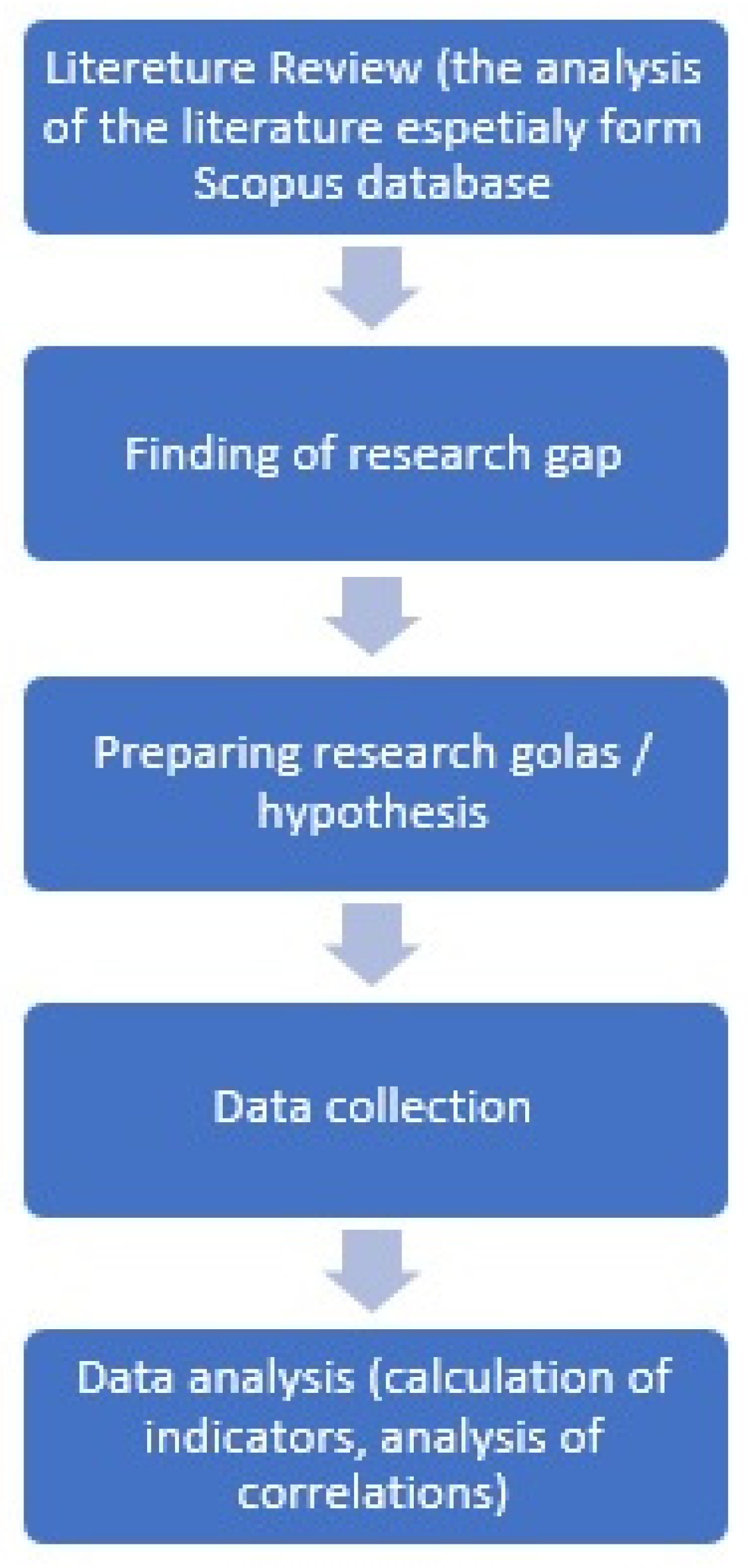
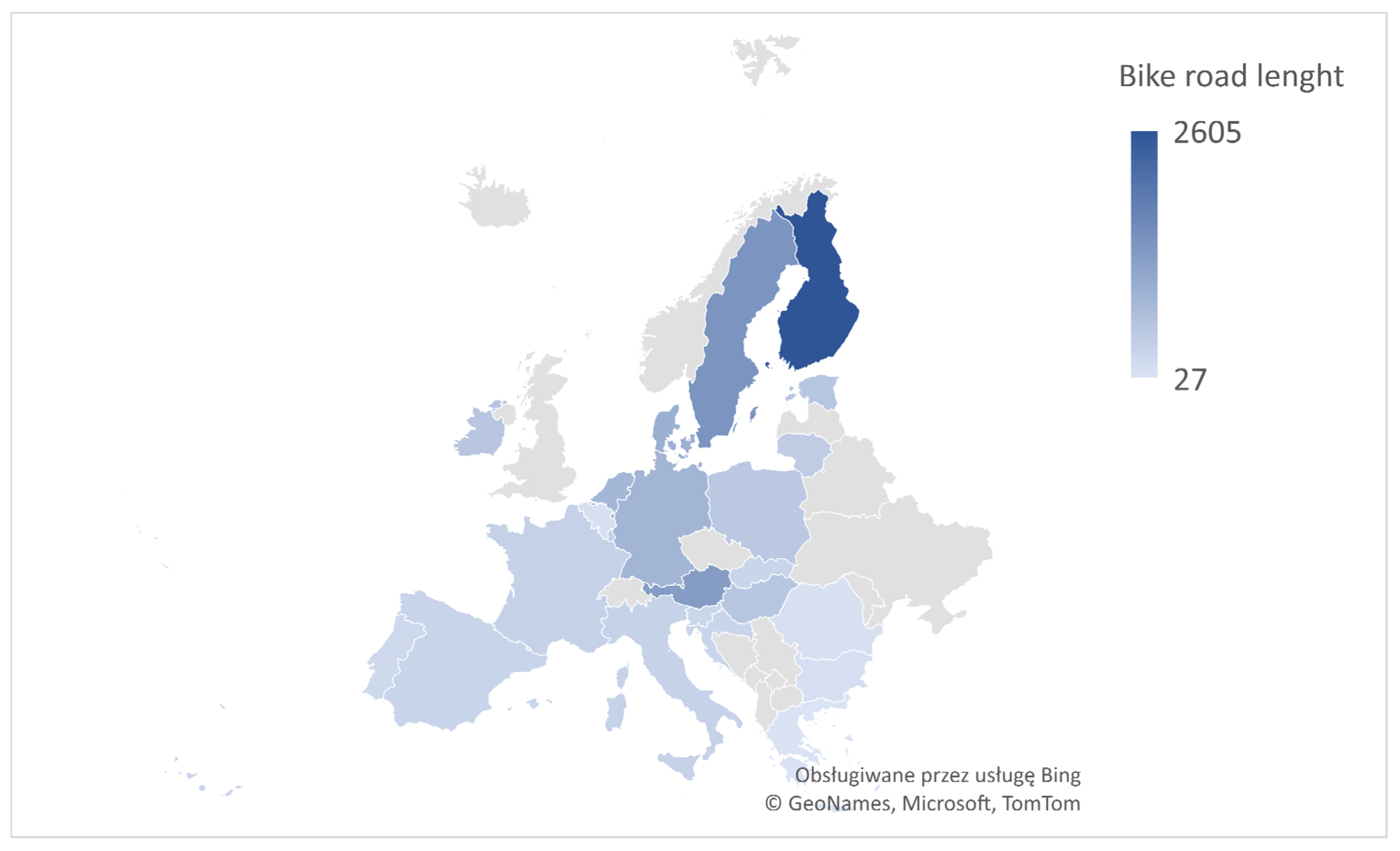
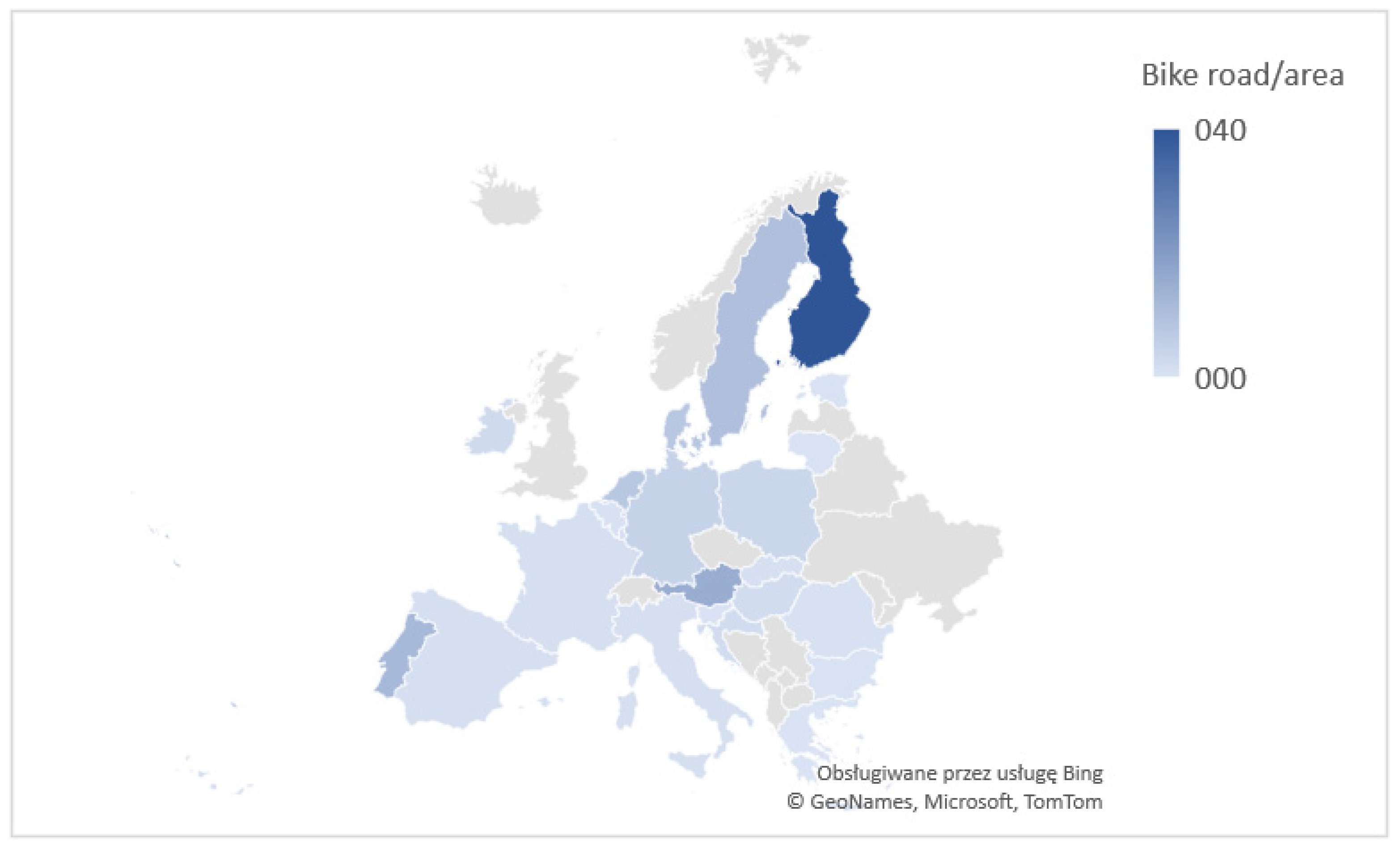
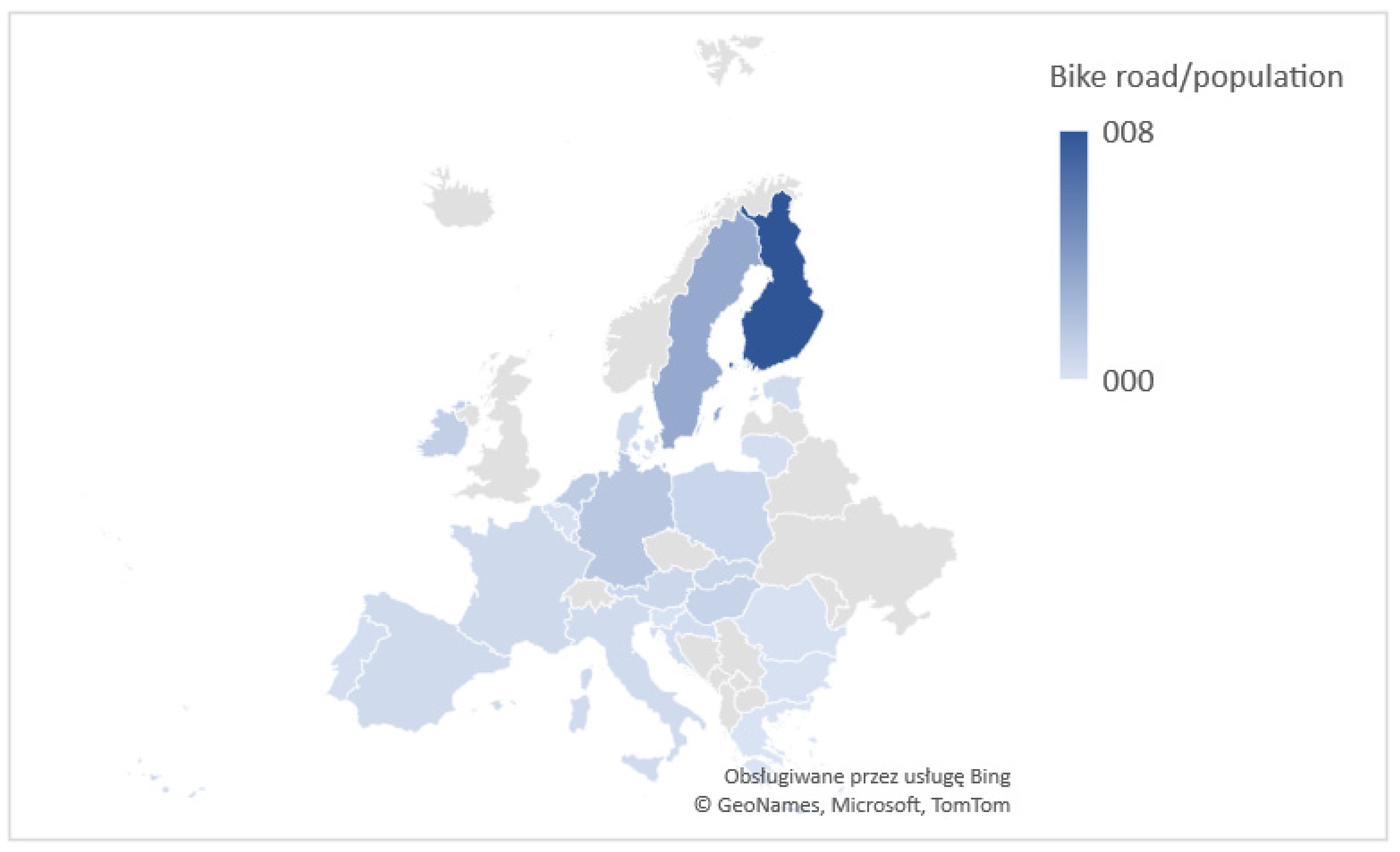
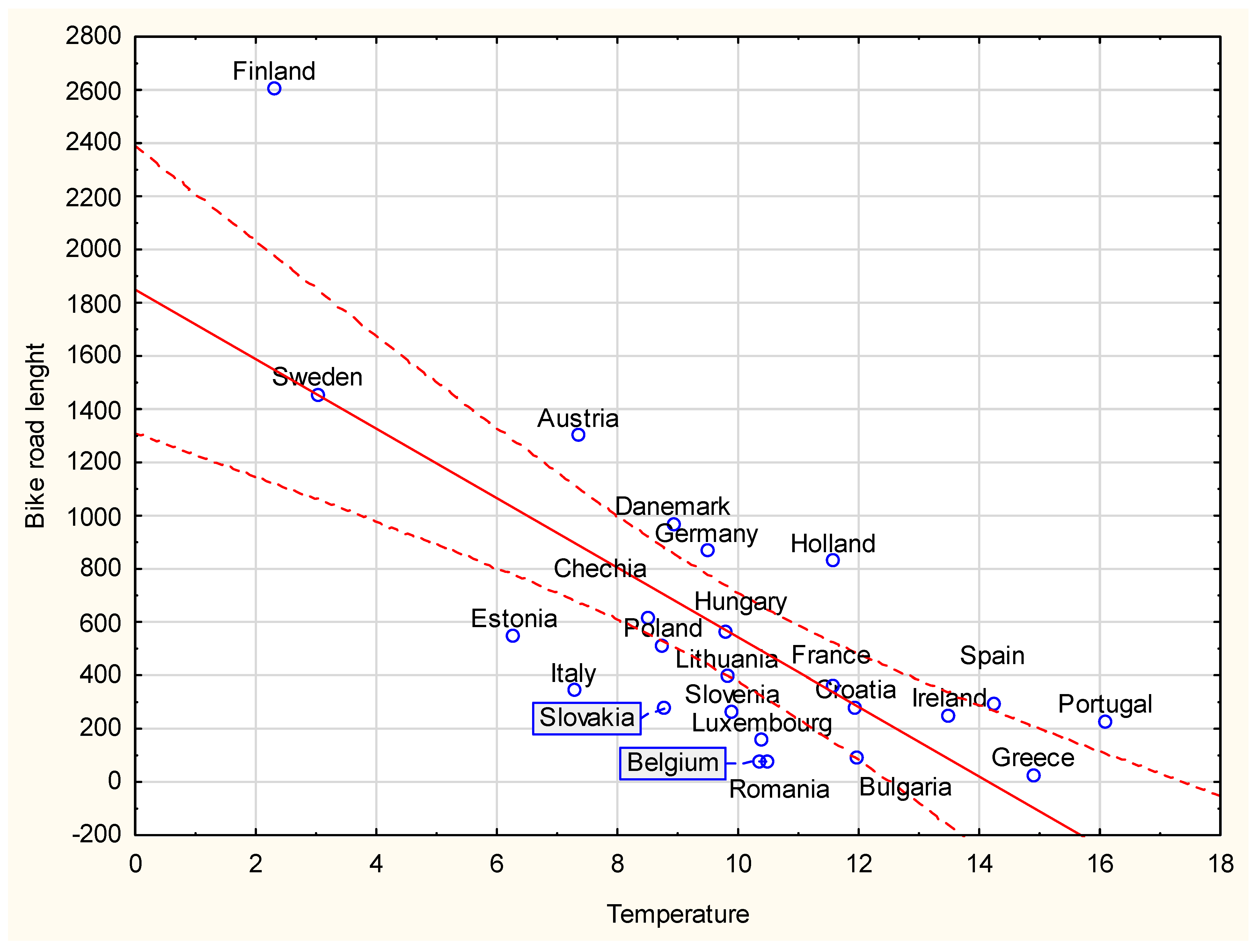
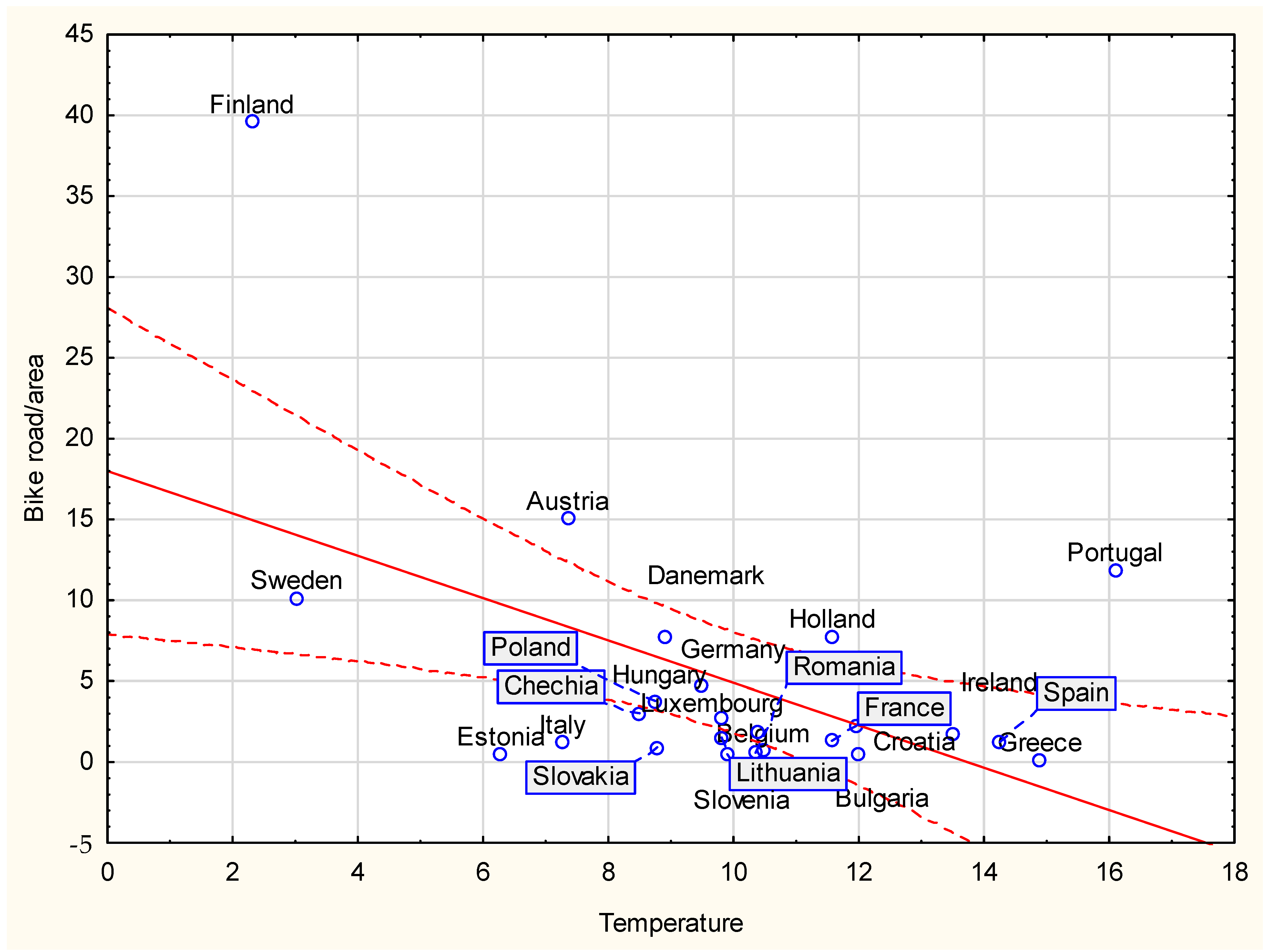
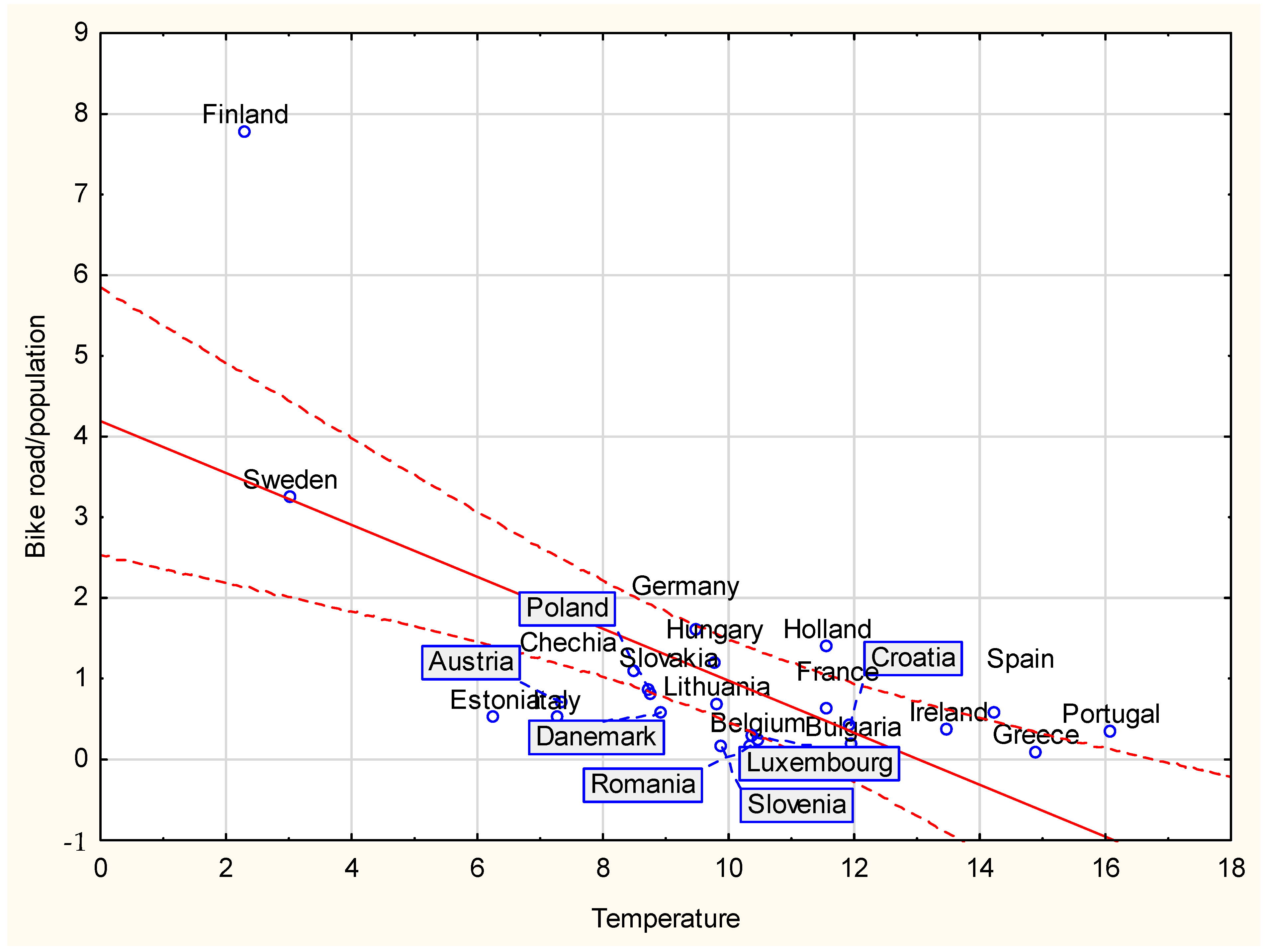
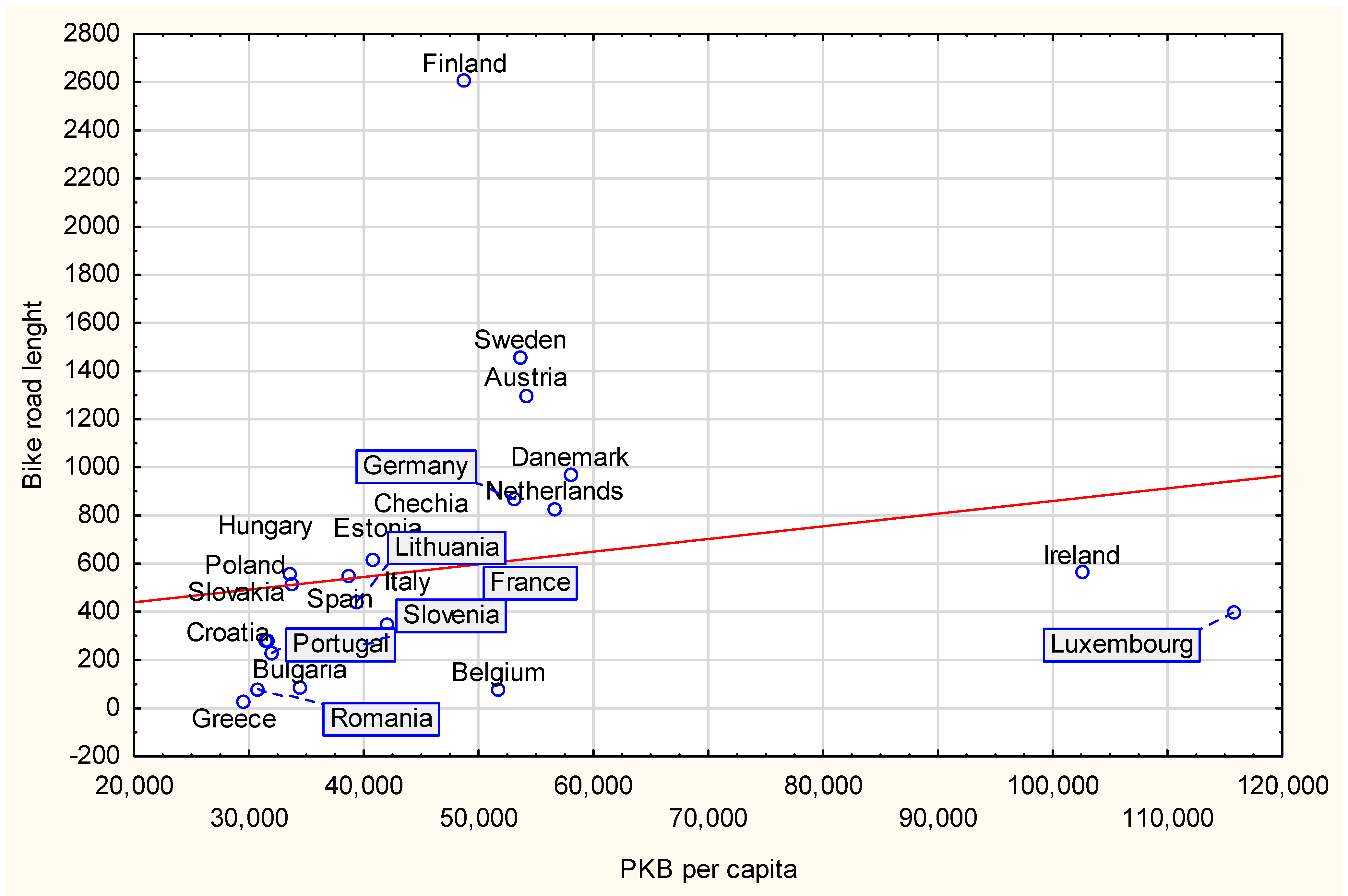


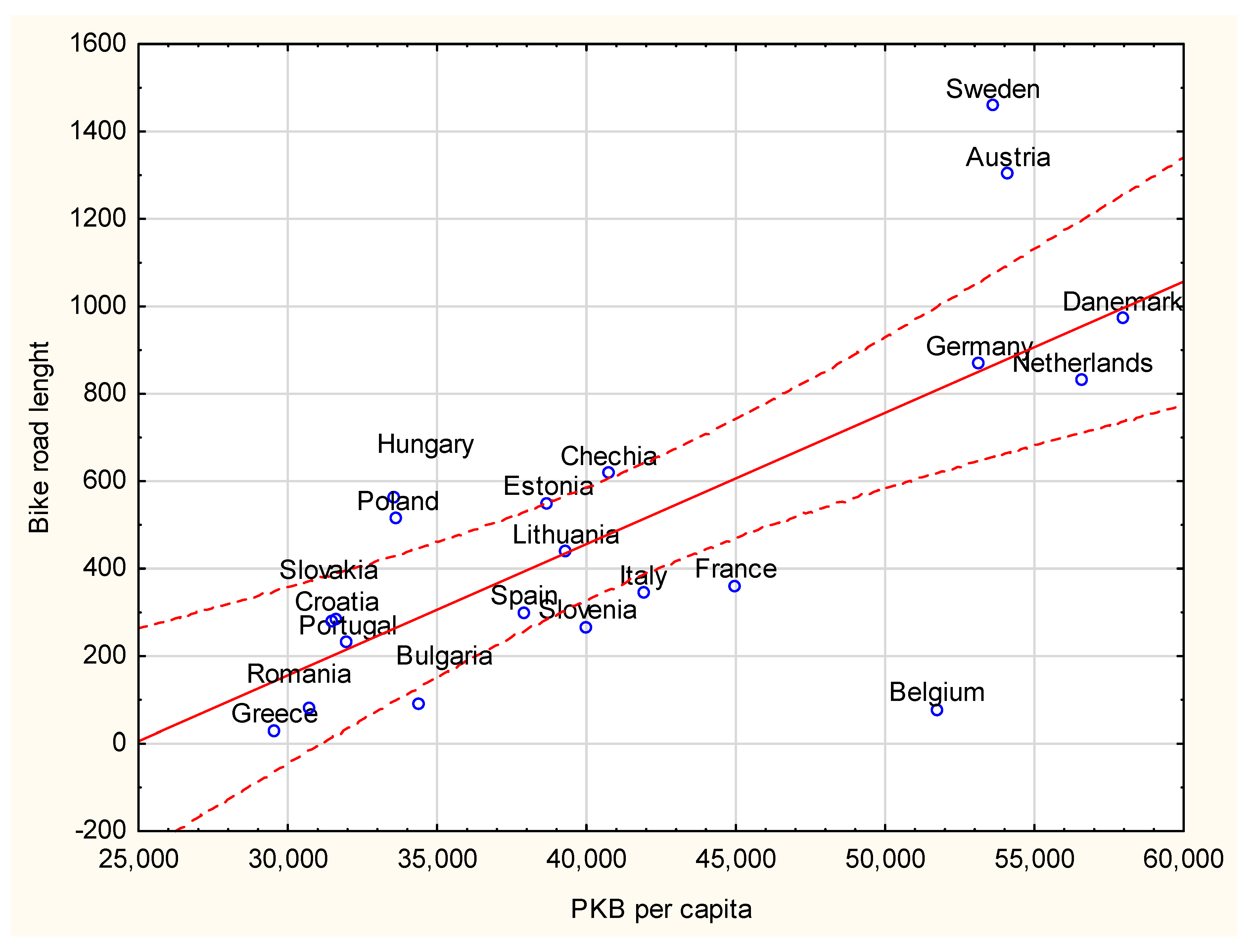
| No | Country | City |
|---|---|---|
| 1 | Austria | Vienna |
| 2 | Belgium | Brussels |
| 3 | Bulgaria | Plovdiv, Varna, Sofia |
| 4 | Chechia | Prague |
| 5 | Croatia | Zagreb |
| 6 | Denmark | Copenhagen, Aarhus |
| 7 | Estonia | Tallinn |
| 8 | Finland | Helsinki |
| 9 | France | Nantes, Toulouse, Lyon, Paris, Nice, Marseille |
| 10 | Germany | Hannover, Munster, Bremen, Mannheim, Bonn, Dusseldorf, Munich, Nuremberg, Frankfurt, Hamburg, Duisburg, Karlsruhe, Leipzig, Dortmund, Essen, Berlin, Bielefeld, Bochum, Dresden, Stuttgart, Wuppertal, Cologne |
| 11 | Greece | Thessaloniki |
| 12 | Netherlands | Amsterdam, Hague, Antwerp, Rotterdam, Utrecht |
| 13 | Hungary | Budapest |
| 14 | Ireland | Dublin |
| 15 | Italy | Bologna, Turin, Florence, Milan, Rome |
| 16 | Lithuania | Vilnius |
| 17 | Luxembourg | Luxembourg |
| 18 | Poland | Wroclaw, Warsaw, Poznan, Lublin, Krakow, Bydgoszcz, Gdansk, Szczecin, Lodz, |
| 19 | Portugal | Lisbon |
| 20 | Romania | Timisoara, Cluj-Napoca, Iasi |
| 21 | Slovakia | Bratislava |
| 22 | Slovenia | Ljubljana |
| 23 | Spain | Valencia, Seville, Alicante, Palma, Barcelona, Zaragoza, Cordoba, Bilbao, Madrid, Malaga, Murcia |
| 24 | Sweden | Malmo, Stockholm, Gothenburg |
| No | Country | City | Bike Road Length [75] | Road Length [75,85] |
|---|---|---|---|---|
| 1 | Austria | Vienna | 1300.76 | 16,373.93 |
| 2 | Belgium | Brussels | 76.43 | 883.91 |
| 3 | Bulgaria | Plovdiv | 94.83 | 2263.45 |
| 4 | Bulgaria | Varna | 66.19 | 4227.75 |
| 5 | Bulgaria | Sofia | 105.59 | 6559.59 |
| 6 | Chechia | Prague | 616.48 | 20,785.67 |
| 7 | Croatia | Zagreb | 282.71 | 9550.99 |
| 8 | Denmark | Copenhagen | 741.25 | 4616.33 |
| 9 | Denmark | Aarhus | 1198.52 | 10,146.21 |
| 10 | Estonia | Tallinn | 548.38 | 6622.59 |
| 11 | Finland | Helsinki | 2605.18 | 14,339.53 |
| 12 | France | Nantes | 380.41 | 2780.18 |
| 13 | France | Toulouse | 666.92 | 5297.21 |
| 14 | France | Lyon | 275.93 | 2494.39 |
| 15 | France | Paris | 570.13 | 6174.52 |
| 16 | France | Nice | 69.97 | 2297.05 |
| 17 | France | Marseille | 190.18 | 7685.41 |
| 18 | Germany | Hannover | 1026.46 | 8361.35 |
| 19 | Germany | Munster | 927.77 | 7347.75 |
| 20 | Germany | Bremen | 1286.57 | 10,271.45 |
| 21 | Germany | Mannheim | 516.43 | 6018.61 |
| 22 | Germany | Bonn | 523.75 | 5416.14 |
| 23 | Germany | Dusseldorf | 848.48 | 8323.37 |
| 24 | Germany | Munich | 1655.97 | 16,984.83 |
| 25 | Germany | Nuremberg | 677.60 | 7610.35 |
| 26 | Germany | Frankfurt | 729.99 | 9883.29 |
| 27 | Germany | Hamburg | 1789.60 | 25,557.07 |
| 28 | Germany | Duisburg | 618.59 | 7576.48 |
| 29 | Germany | Karlsruhe | 414.68 | 6689.29 |
| 30 | Germany | Leipzig | 765.12 | 10,092.79 |
| 31 | Germany | Dortmund | 812.07 | 11,626.20 |
| 32 | Germany | Essen | 632.29 | 8762.29 |
| 33 | Germany | Berlin | 2478.84 | 39,808.56 |
| 34 | Germany | Bielefeld | 566.32 | 8597.44 |
| 35 | Germany | Bochum | 404.68 | 6842.48 |
| 36 | Germany | Dresden | 440.30 | 10,779.37 |
| 37 | Germany | Stuttgart | 399.69 | 9192.64 |
| 38 | Germany | Wuppertal | 111.33 | 2645.89 |
| 39 | Greece | Thessaloniki | 26.88 | 917.16 |
| 40 | Germany | Cologne | 1466.25 | 14,756.88 |
| 41 | Netherlands | Amsterdam | 1259.29 | 8661.93 |
| 42 | Netherlands | Hague | 548.46 | 4693.86 |
| 43 | Netherlands | Antwerp | 906.37 | 5693.08 |
| 44 | Netherlands | Rotterdam | 875.16 | 5962.23 |
| 45 | Netherlands | Utrecht | 559.15 | 3609.50 |
| 46 | Hungary | Budapest | 561.19 | 18,618.63 |
| 47 | Ireland | Dublin | 251.86 | 6009.99 |
| 48 | Italy | Bologna | 408.03 | 3739.61 |
| 49 | Italy | Turin | 305.84 | 4815.10 |
| 50 | Italy | Florence | 178.57 | 4764.17 |
| 51 | Italy | Milan | 385.87 | 8008.79 |
| 52 | Italy | Rome | 437.20 | 21,712.35 |
| 53 | Lithuania | Vilnius | 396.11 | 11,206.06 |
| 54 | Luxembourg | Luxembourg | 157.74 | 2254.80 |
| 55 | Poland | Wroclaw | 651.56 | 12,543.52 |
| 56 | Poland | Warsaw | 1384.10 | 27,151.26 |
| 57 | Poland | Poznan | 498.89 | 11,518.12 |
| 58 | Poland | Lublin | 322.13 | 7256.87 |
| 59 | Poland | Krakow | 443.50 | 12,179.54 |
| 60 | Poland | Bydgoszcz | 275.29 | 6983.12 |
| 61 | Poland | Gdansk | 356.20 | 9093.51 |
| 62 | Poland | Szczecin | 283.59 | 8112.34 |
| 63 | Poland | Lodz | 401.84 | 13,668.31 |
| 64 | Portugal | Lisbon | 228.75 | 4434.45 |
| 65 | Romania | Timisoara | 106.81 | 2414.10 |
| 66 | Romania | Cluj-Napoca | 76.86 | 2868.69 |
| 67 | Romania | Iasi | 57.52 | 2127.85 |
| 68 | Slovakia | Bratislava | 275.52 | 10,779.00 |
| 69 | Slovenia | Ljubljana | 264.76 | 6485.76 |
| 70 | Spain | Valencia | 511.10 | 4143.81 |
| 71 | Spain | Seville | 365.77 | 4250.41 |
| 72 | Spain | Alicante | 260.31 | 4221.62 |
| 73 | Spain | Palma | 148.59 | 4050.32 |
| 74 | Spain | Barcelona | 352.64 | 7881.66 |
| 75 | Spain | Zaragoza | 267.71 | 10,067.73 |
| 76 | Spain | Cordoba | 185.05 | 6096.96 |
| 77 | Spain | Bilbao | 63.33 | 1693.15 |
| 78 | Spain | Madrid | 652.18 | 19,203.75 |
| 79 | Spain | Malaga | 187.31 | 7647.25 |
| 80 | Spain | Murcia | 276.10 | 11,143.40 |
| 81 | Sweden | Malmo | 926.26 | 4427.65 |
| 82 | Sweden | Stockholm | 1845.44 | 10,363.48 |
| 83 | Sweden | Gothenburg | 1598.82 | 12,253.42 |
| No | City | Population [85] | Area [85] | Bike Road/Area | Bike Road/Population | Bike Road/Road |
|---|---|---|---|---|---|---|
| 1 | Austria | 2187.2 | 471.40 | 2.54 | 0.55 | 11.8% |
| 2 | Belgium | 634.8 | 202.55 | 1.29 | 0.41 | 6.2% |
| 3 | Bulgaria | 513.3 | 219.50 | 5.74 | 2.45 | 14.5% |
| 4 | Bulgaria | 1221.8 | 203.70 | 4.45 | 0.74 | 15.9% |
| 5 | Bulgaria | 886.8 | 38.07 | 9.26 | 0.40 | 4.5% |
| 6 | Chechia | 821.7 | 101.32 | 24.46 | 3.02 | 6.2% |
| 7 | Croatia | 506.9 | 116.24 | 4.87 | 1.12 | 6.6% |
| 8 | Denmark | 354 | 891.14 | 0.07 | 0.18 | 3.7% |
| 9 | Denmark | 388.4 | 258.83 | 1.56 | 1.04 | 5.9% |
| 10 | Estonia | 944.3 | 40.62 | 10.04 | 0.43 | 10.9% |
| 11 | Finland | 322.1 | 145.66 | 3.60 | 1.63 | 9.7% |
| 12 | France | 344.2 | 140.67 | 1.96 | 0.80 | 2.6% |
| 13 | France | 472.1 | 141.07 | 9.12 | 2.73 | 12.5% |
| 14 | France | 333.7 | 367.56 | 0.21 | 0.23 | 8.6% |
| 15 | France | 475.5 | 326.29 | 1.72 | 1.18 | 3.0% |
| 16 | France | 404.5 | 230.23 | 1.20 | 0.68 | 3.9% |
| 17 | France | 324.6 | 162.44 | 0.47 | 0.24 | 2.7% |
| 18 | Germany | 567.6 | 240.38 | 6.10 | 2.58 | 9.9% |
| 19 | Germany | 1222.6 | 526.15 | 1.41 | 0.61 | 16.1% |
| 20 | Germany | 544.4 | 175.85 | 1.05 | 0.34 | 3.0% |
| 21 | Germany | 354.4 | 181.66 | 4.47 | 2.29 | 7.0% |
| 22 | Germany | 2873 | 179.16 | 2.46 | 0.15 | 4.1% |
| 23 | Germany | 696.7 | 405.01 | 0.62 | 0.36 | 4.2% |
| 24 | Germany | 587 | 121.88 | 5.08 | 1.05 | 8.2% |
| 25 | Germany | 1472.3 | 108.95 | 7.79 | 0.58 | 10.2% |
| 26 | Germany | 315.2 | 1255.41 | 0.50 | 2.01 | 7.2% |
| 27 | Germany | 688.7 | 82.03 | 2.18 | 0.26 | 3.7% |
| 28 | Germany | 313.1 | 280.84 | 2.60 | 2.33 | 7.4% |
| 29 | Germany | 504.7 | 328.48 | 1.08 | 0.71 | 3.9% |
| 30 | Germany | 426.5 | 118.62 | 13.48 | 3.75 | 13.0% |
| 31 | Germany | 309.4 | 232.77 | 2.36 | 1.77 | 11.7% |
| 32 | Germany | 587.9 | 217.49 | 8.23 | 3.04 | 7.0% |
| 33 | Germany | 1309 | 210.38 | 4.88 | 0.78 | 12.3% |
| 34 | Germany | 335.2 | 102.42 | 25.44 | 7.77 | 18.2% |
| 35 | Germany | 579.3 | 248.68 | 0.23 | 0.10 | 2.7% |
| 36 | Germany | 583.1 | 243.85 | 1.70 | 0.71 | 6.2% |
| 37 | Germany | 766.7 | 266.95 | 1.66 | 0.58 | 3.6% |
| 38 | Germany | 3664.1 | 241.00 | 3.17 | 0.21 | 7.6% |
| 39 | Greece | 673.9 | 1093.63 | 0.21 | 0.34 | 5.2% |
| 40 | Germany | 1756 | 98.14 | 2.70 | 0.15 | 4.1% |
| 41 | Netherlands | 3266.1 | 980.29 | 0.41 | 0.12 | 2.9% |
| 42 | Netherlands | 1860.3 | 204.01 | 1.58 | 0.17 | 4.4% |
| 43 | Netherlands | 554.6 | 717.65 | 0.22 | 0.28 | 7.0% |
| 44 | Netherlands | 536.1 | 91.49 | 3.02 | 0.51 | 11.1% |
| 45 | Netherlands | 801.6 | 173.54 | 3.76 | 0.81 | 3.4% |
| 46 | Hungary | 1620.8 | 326.85 | 0.57 | 0.12 | 2.4% |
| 47 | Ireland | 1897.1 | 297.89 | 3.11 | 0.49 | 20.9% |
| 48 | Italy | 314.3 | 86.82 | 5.95 | 1.64 | 8.6% |
| 49 | Italy | 345.8 | 275.06 | 0.69 | 0.55 | 2.5% |
| 50 | Italy | 409.7 | 293.26 | 1.32 | 0.94 | 4.8% |
| 51 | Italy | 518.4 | 147.45 | 11.23 | 3.19 | 9.7% |
| 52 | Italy | 319.3 | 51.73 | 17.93 | 2.91 | 12.6% |
| 53 | Lithuania | 325.7 | 47.98 | 5.75 | 0.85 | 2.5% |
| 54 | Luxembourg | 656.2 | 604.89 | 0.63 | 0.58 | 13.7% |
| 55 | Poland | 308.8 | 395.70 | 0.18 | 0.23 | 3.0% |
| 56 | Poland | 753.1 | 86.46 | 7.84 | 0.90 | 8.9% |
| 57 | Poland | 544.1 | 144.98 | 1.02 | 0.27 | 3.7% |
| 58 | Poland | 498.6 | 242.14 | 2.35 | 1.14 | 9.2% |
| 59 | Poland | 342 | 181.89 | 0.52 | 0.28 | 4.2% |
| 60 | Poland | 364.6 | 310.71 | 1.61 | 1.37 | 4.3% |
| 61 | Poland | 574.7 | 303.30 | 2.03 | 1.07 | 3.0% |
| 62 | Poland | 122.3 | 918.26 | 0.48 | 3.57 | 2.0% |
| 63 | Poland | 806.3 | 65.80 | 13.30 | 1.09 | 14.7% |
| 64 | Portugal | 619.3 | 118.58 | 3.08 | 0.59 | 8.6% |
| 65 | Romania | 975.6 | 74.19 | 1.42 | 0.11 | 1.6% |
| 66 | Romania | 336.4 | 20.53 | 89.91 | 5.49 | 17.8% |
| 67 | Romania | 540 | 187.35 | 2.13 | 0.74 | 4.3% |
| 68 | Slovakia | 279.7 | 160.05 | 1.77 | 1.01 | 3.5% |
| 69 | Slovenia | 1073.1 | 208.73 | 2.63 | 0.51 | 8.3% |
| 70 | Spain | 319.3 | 105.39 | 0.26 | 0.08 | 2.9% |
| 71 | Spain | 623.7 | 112.52 | 0.95 | 0.17 | 4.4% |
| 72 | Spain | 868.3 | 261.92 | 2.55 | 0.77 | 12.6% |
| 73 | Spain | 549.2 | 496.27 | 0.62 | 0.56 | 6.4% |
| 74 | Spain | 602.5 | 304.01 | 1.84 | 0.93 | 15.5% |
| 75 | Spain | 343.4 | 1286.58 | 0.40 | 1.49 | 12.3% |
| 76 | Spain | 447.2 | 128.84 | 0.51 | 0.15 | 1.6% |
| 77 | Spain | 1841 | 141.29 | 9.21 | 0.71 | 7.9% |
| 78 | Spain | 582.2 | 177.00 | 2.24 | 0.68 | 3.5% |
| 79 | Spain | 1360 | 215.75 | 6.42 | 1.02 | 5.1% |
| 80 | Spain | 311.2 | 207.32 | 3.14 | 2.09 | 5.2% |
| 81 | Sweden | 328.6 | 300.55 | 0.37 | 0.34 | 4.2% |
| 82 | Sweden | 666.9 | 159.46 | 1.77 | 0.42 | 3.0% |
| 83 | Sweden | 368.4 | 19.29 | 13.88 | 0.73 | 2.7% |
| No | Country | Number of Cities | Average Bike Road Length | Average Road Length |
|---|---|---|---|---|
| 1 | Austria | 1 | 1300.76 | 16,373.93 |
| 2 | Belgium | 1 | 76.43 | 883.91 |
| 3 | Bulgaria | 3 | 88.87 | 4350.26 |
| 4 | Chechia | 1 | 616.48 | 20,785.67 |
| 5 | Croatia | 1 | 282.71 | 9550.99 |
| 6 | Denmark | 2 | 969.88 | 7381.2 |
| 7 | Estonia | 1 | 548.38 | 6622.59 |
| 8 | Finland | 1 | 2605.18 | 14,339.53 |
| 9 | France | 6 | 358.9 | 4454.79 |
| 10 | Germany | 22 | 867.85 | 11,052.02 |
| 11 | Greece | 1 | 26.88 | 917.16 |
| 12 | Hungary | 1 | 559.15 | 3609.50 |
| 13 | Ireland | 1 | 561.19 | 18,618.63 |
| 14 | Italy | 5 | 343.1 | 8608 |
| 15 | Lithuania | 1 | 437.20 | 21,712.35 |
| 16 | Luxembourg | 1 | 396.11 | 11,206.06 |
| 17 | Netherlands | 5 | 829.68 | 5724.118 |
| 18 | Poland | 9 | 513.01 | 12,056 |
| 19 | Portugal | 1 | 228.75 | 4434.45 |
| 20 | Romania | 3 | 80.4 | 2470.21 |
| 21 | Slovakia | 1 | 275.52 | 10,779.00 |
| 22 | Slovenia | 1 | 264.76 | 6485.76 |
| 23 | Spain | 11 | 297.28 | 7309.1 |
| 24 | Sweden | 3 | 1456.4 | 9014.85 |
| No | Country | Average Bike Road/Area | Average Bike Road/Population | Average Bike Road/Road |
|---|---|---|---|---|
| 1 | Austria | 15.05 | 0.71 | 7.9% |
| 2 | Belgium | 0.70 | 0.23 | 8.6% |
| 3 | Bulgaria | 0.43 | 0.18 | 2.5% |
| 4 | Chechia | 3.02 | 1.07 | 3.0% |
| 5 | Croatia | 2.19 | 0.42 | 3.0% |
| 6 | Denmark | 7.71 | 0.58 | 14.0% |
| 7 | Estonia | 0.50 | 0.51 | 8.3% |
| 8 | Finland | 39.60 | 7.77 | 18% |
| 9 | France | 1.31 | 0.63 | 8.7% |
| 10 | Germany | 4.77 | 1.59 | 8.0% |
| 11 | Greece | 0.13 | 0.08 | 2.9% |
| 12 | Netherlands | 2.03 | 0.93 | 15.5% |
| 13 | Hungary | 2.69 | 1.18 | 3.0% |
| 14 | Ireland | 1.24 | 0.51 | 5.6% |
| 15 | Italy | 0.35 | 0.35 | 2.0% |
| 16 | Lithuania | 1.51 | 0.68 | 3.5% |
| 17 | Luxembourg | 7.76 | 1.39 | 14.4% |
| 18 | Poland | 3.78 | 0.86 | 4.0% |
| 19 | Portugal | 11.86 | 0.34 | 5.2% |
| 20 | Romania | 0.58 | 0.17 | 3.3% |
| 21 | Slovakia | 0.92 | 0.80 | 2.6% |
| 22 | Slovenia | 0.44 | 0.15 | 4.1% |
| 23 | Spain | 1.24 | 0.56 | 4.8% |
| 24 | Sweden | 10.14 | 3.24 | 17.3% |
Disclaimer/Publisher’s Note: The statements, opinions and data contained in all publications are solely those of the individual author(s) and contributor(s) and not of MDPI and/or the editor(s). MDPI and/or the editor(s) disclaim responsibility for any injury to people or property resulting from any ideas, methods, instructions or products referred to in the content. |
© 2023 by the author. Licensee MDPI, Basel, Switzerland. This article is an open access article distributed under the terms and conditions of the Creative Commons Attribution (CC BY) license (https://creativecommons.org/licenses/by/4.0/).
Share and Cite
Wolniak, R. European Union Smart Mobility–Aspects Connected with Bike Road System’s Extension and Dissemination. Smart Cities 2023, 6, 1009-1042. https://doi.org/10.3390/smartcities6020049
Wolniak R. European Union Smart Mobility–Aspects Connected with Bike Road System’s Extension and Dissemination. Smart Cities. 2023; 6(2):1009-1042. https://doi.org/10.3390/smartcities6020049
Chicago/Turabian StyleWolniak, Radosław. 2023. "European Union Smart Mobility–Aspects Connected with Bike Road System’s Extension and Dissemination" Smart Cities 6, no. 2: 1009-1042. https://doi.org/10.3390/smartcities6020049
APA StyleWolniak, R. (2023). European Union Smart Mobility–Aspects Connected with Bike Road System’s Extension and Dissemination. Smart Cities, 6(2), 1009-1042. https://doi.org/10.3390/smartcities6020049






